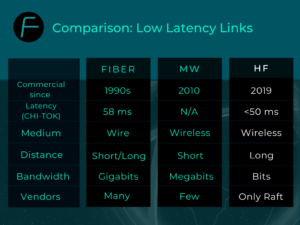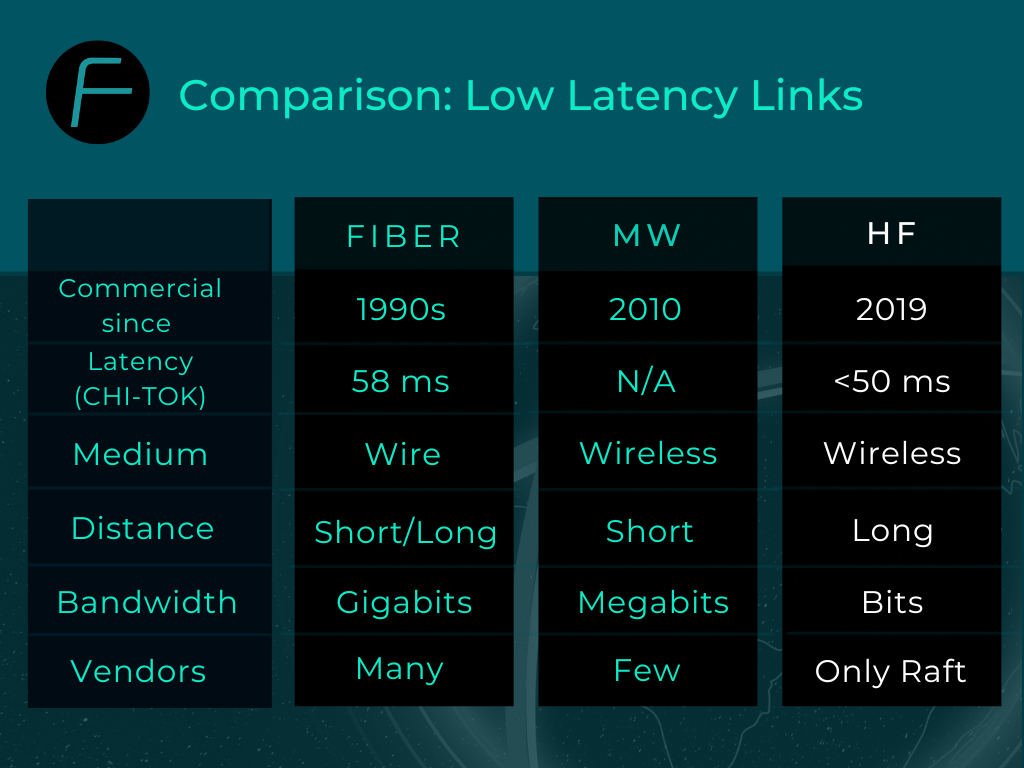The Latency Race
People say that time is money. It’s even an understatement when you realize that a few milliseconds can be the difference between a win or a loss. So if cutting down milliseconds is so important, let’s dive into the available low-latency solutions: What are their unique characteristics? What can you expect from every solution? And more…
The Solutions
Fiber: A cable that sends coded information in a beam of light down a glass or plastic pipe. Initially developed for endoscopes in the 1950s to help doctors see inside the human body without having to cut it open first. In the 1960s, engineers found a way of using the same technology to transmit telephone calls at the speed of light. The speed of light is 300,000 km per second in a vacuum, and pretty much that is through the air, but it slows to about two-thirds this speed in a fiber-optic cable. This fact pushed the low latency evolution into wireless connectivity.
Microwave: The history of microwave communications includes discoveries of Morse, Maxwell, Hertz, Marconi, and other pioneers of the radio and electronics fields. Even though the first microwave line-of-sight systems were demonstrated and placed in service during the 1930s, it was not until the late 1940s and early 1950s that microwave transmission systems were implemented. The 1960s and 1970 witnessed significant progress in the technology and application of line-of-sight microwave communication systems. The limitation of microwaves needing a line-of-site or short distance between stations pushed the low latency evolution into long-distance wireless connectivity.
High Frequency (HF) / Skywaves: High Frequency or Shortwave radio is radio transmission using a frequency band extending from 3 to 30 MHz. This radio frequency has unique characteristics – it bounces back from the earth’s Ionosphere, acting as a mirror; hence named Skywave. HF has been known and used since the early 19s for long-distance communication, most notably in the military (e.g., linking a ground base with airplanes or submarines). Recent technology advancements enabled using HF for long-distance, low-latency data transfers.
Paths & Operations
Fiber: A physical cable – a wire that can cross thousands of kilometers. Due to many geographic limitations, most of the Fiber links are not laying in straight lines. For instance, one limitation is that a Fiber link must be set inside sub-marine cables in the ocean, while sometimes crossing the land is shorter.
Microwave: The technology enables a communication point-to-point Line of Sight (LOS), near Line of Sight (nLOS), or Non-Line of Sight (NLOS). The more direct the sight between sites (…) the longer the distance the signal can cross. Due to the high frequencies (2.4-42GHz) the technology uses, the distance between the transmitter and the receiver is limited; 60 kilometers is the maximal stretch, and, of course, sites can only be built on the land. Those limitations affect long-distance communication capabilities they require multi-base stations to support the distance, affecting the latency as well as the cost of the build. Another point to mention – microwave communications are disturbed by bad weather like storms or snow.
HF / Skywaves: HF’s links use the sky as a “cable” medium. Skywave communication involves transmitting the HF signal beyond the horizon, using the reflation of the signal by the earth’s Ionosphere and surface. The signal hopes between only two sites – transmitter and receiver, making the shortest possible path (on the geodesic line connecting two points on a circle). The reflection of the HF signal occurs due to the ionization created by solar radiation. During the day and night, changes in the power of ionization cause changes in the reflection coefficient, affecting the frequency propagating between two points. Weather on earth is not affecting HF transmission, space weather (e.g., sun storms do).
Bandwidth
Fiber: The maximum current bandwidth for fiber-optic cabling is 100Gbps. But research is being done to increase speed and bandwidth even further. In 2021, Japanese scientists set a new world record by developing a four-core optical fiber achieving record-breaking speeds of 319 Tb/s.
Microwave: In traditional frequency bands, microwave links can reach speeds between 300 Mbps and 1 Gbps.
HF: The bandwidth is small, reaching about 1.2 kbps by transferring several bits of data to send signals that will arrive with the lowest possible latency.
Latency
Let’s examine a route between Chicago and Tokyo (the distance is more than 10 Km to see who will first cross the finish line.
Fiber and microwave (on land) combination: the fastest latency will be 58ms to send a message from Chicago to Tokyo.
Microwave: Cannot stretch along to such distances or cross the ocean
HF: A signal sent from Chicago to Tokyo over HF will arrive significantly short of 50ms (this number includes the last mile over microwave links from HF sites to the data centers).
Summary




